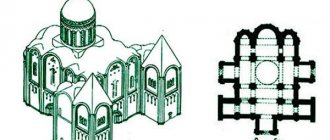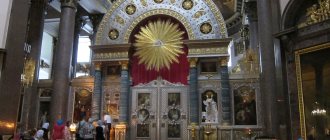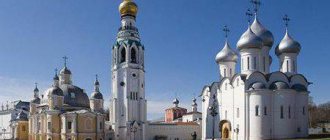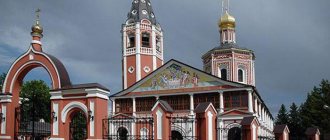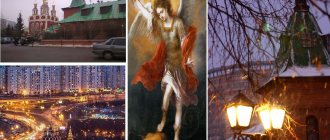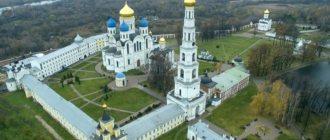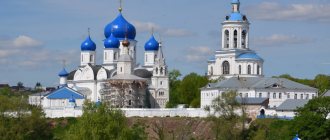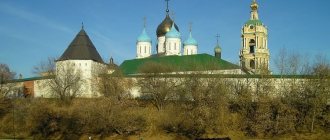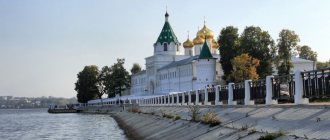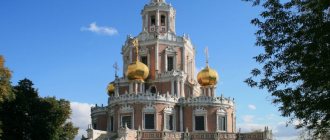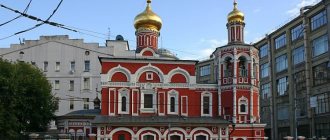The Church of the Holy Great Martyr Catherine on Vspolye is an Orthodox church located on Bolshaya Ordynka Street in Moscow, built in the Baroque style. The first information about the wooden church of the saint dates back to the 16th century. It was built on the initiative of Anastasia Romanovna, the first wife of Ivan Vasilyevich the Terrible. They pray to the Holy Great Martyr Catherine for an easy upcoming birth and for the protection of their children.
Vpolye in those distant times meant “arable land”; such territory was located outside the urban settlement. According to other sources, this wooden church was built on the site of a battle between Russian troops and Polish-Lithuanian troops. At the Klimentovsky fort, the enemy was defeated and Hetman Khotkevich decided to transfer the army to this place in order to build a fortification here. But this tactic did not help the Polish-Lithuanian army; the Russian knights were able to win.
In 1657, the church was rebuilt; instead of the previous wooden one, a stone church appeared. Since 1625, the chapel of Theodore the Studite has been built, and in 1636, the chapel of St. Nicholas. The next renovation of the church is documented in 1696. In its current form, the temple was built in the period 1766–1775. Carl Blanca worked on the project.
There is an assumption that Catherine II herself ordered this work when she ascended the throne. The new church building was built next to the old one and both of these churches were united by a large two-tier bell tower. The lower tier was used as the porch of the main Catherine Church. It was decided to preserve the old refectory, and the chapel of Theodore the Studite was dismantled.
As for the chapel of St. Nicholas, it existed for a long time and acted as a winter temple. At the top, the temple was created in the form of an octagon, on which there were domes. Large frames and elegant stucco molding were used, which successfully complemented the image of the church.
Karl Blank was able to revive a composition that was considered traditional for Russian architecture. It consisted of a warm and cold temple, and between it there was a large bell tower, which brought these buildings together. The construction of the temple according to the design of Karl Blank was carried out with government money. The Empress herself donated a precious robe, which became the decoration of the icon of St. Catherine. The iconostasis contained works by D. G. Levitsky and V. I. Vasilevsky. To this day, the icons that they painted have not survived.
© Svetlana Tikhonova
The temple fence has its own separate history. For a long time, it has been customary to decorate a house with beautiful carved gates and fences. With their help, they tried to emphasize the importance of housing for their family and show it to those passing by. By the appearance of the fence one could judge the hospitality of the owners. A decorated fence has always symbolized peace and tranquility. They especially carefully tried to decorate the gates and gates of temples. This can be seen in surviving images from that time.
A fence appeared near the Church of St. Catherine the Great Martyr on Vspolye in 1769. It consisted of stone and metal elements. The fence contained forged links created in 1730 by palace craftsmen, according to the design of H. Conrad. These elements were intended to fence the famous Cathedral Square of the Kremlin. The lattice itself adorned the Kremlin until 1740 and was located between the Patriarchal Court and the Archangel Cathedral.
The fence was dismantled in 1740, and in 1762 it was decided to transfer the links to the newly built church. This was done on the orders of Catherine. The pillars were decorated with pilasters, and the gates with large pylons. This entire composition was successfully complemented by white stone eagles. On the central grilles one could see Russian forged coats of arms.
The stone part of the fence was designed under the leadership of Karl Blank, in 1763–1767. A fence with two gates became part of the development of Bolshaya Ordynka Street. The fence was installed on a white stone plinth. Pillars with pilasters were located at equal distances, decorating the eaves of a large extension. The white stone flowerpots were located on the side of Bolshaya Ordynka, they were made in the form of Catherine’s crown.
© Artem Kulikovsky
On the side of Bolshoy Ekaterininsky Lane there were flowerpots decorated with Catherine’s monograms in the form of medallions. Forged bars and gate leaves are complemented by horizontal bars, Anninsky crowns and eight-pointed stars. The corner, which was at the junction of the alley and the street, was cut off during the installation of the fence. On the site of the corner stood a chapel.
After the devastating Moscow fire in 1812, the church was badly damaged. There is information that many icons and various utensils were hidden under the church platform. Fyodor Shestakov worked on the restoration of the temple after the fire, who decided to transform the corner part. A one-story gatehouse was built at this location. An additional fence appeared on the western side.
The next reconstruction of the temple took place in 1870–1872; Pavel Prokopyevich Petrov worked on the project. Some experts claim that Dmitry Chichagov was also involved in the project. The Winter Church was rebuilt. The main altar of the church was rededicated - in honor of the Savior, the Image Not Made by Hands, and the side chapels - in honor of Grand Duke Alexander Nevsky and St. Nicholas. The new building was decorated with pilasters, which are similar in decor to the same elements as the summer church. We decided to change the gatehouse, adding arched niches to it.
In 1920–1924, Patriarch Tikhon held a service on the patronal feast day in the Church of the Holy Great Martyr Catherine in Vspolye. In 1931, the church was closed, and the main icon of St. Catherine was moved to the Church of the Resurrection, in Monetchiki. Then this icon ended up in the Church of Florus and Laurus on Zatsep. When this church was closed, the further fate of the icon became unknown.
© Svetlana Tikhonova
The bell tower was destroyed down to the first tier, and the chapters were also dismantled. The Spassky Church was converted into residential premises, and the Catherine Church began to function as an office. Then the building housed an instrument engineering design bureau.
Restoration of the temple began only in the 1970s. In the period from 1970 to 1983, the summer church was restored. This was done by employees of the workshop of the Grabar Institute. After its closure, the warm church was deprived of its bell tower; various industrial enterprises were located in it.
In 1992, the temple was transferred to the Russian Orthodox Church. The first Liturgy was held in 1995, on the Annunciation. The great consecration of the temple took place on June 11, 1999, and it was performed by Patriarch Alexy II. From that moment on, a new religious life began in the church.
Now the church regularly hosts Gospel readings and services. The temple itself regularly engages in charity work. On the territory of the church you can purchase religious literature in Russian and English. For Moscow this is considered a real rarity. Parishioners have access to a library and a free art studio for children.
The temple contains several shrines: a particle of the relics of St. John, the wonderworker of San Francisco and Shanghai, and an icon of the Holy Great Martyr Panteleimon, with a particle of relics. You can visit the temple to see how it looks now, after so many transformations.
© Official group of the Church of the Holy Great Martyr Catherine on Vspolye Vkontakte
Schedule of services in the Church of St. Catherine the Great Martyr on Vspolye
On Saturdays and Sundays, Divine Liturgies are held at 09:00. An all-night vigil is held the day before. Morning liturgy on weekdays takes place at 08:00. Evening worship on weekdays takes place at 18:00. Divine services are performed not only in Church Slavonic, but also in English.
Schedule of the Church of the Holy Great Martyr Catherine on Vspolye
Every Saturday the church holds English classes. Parishioners and clergy read and analyze religious literature in classical and modern translations. Classes start at 15:00.
On Sundays, classes are held to study the Old and New Testaments. At these meetings, chapters from the Gospel are studied and discussed, and reports on the books of Holy Scripture are read. Classes start at 14:00.
The history of the creation of St. Catherine's Cathedral
- The decision to build the temple was made back in 1889 . A year before, Emperor Alexander III with his children and wife visited what was then Yekaterinodar. On the way back, the train met with a disaster, but the royal family miraculously survived. In honor of the miraculous salvation, it was decided to build a cathedral and dedicate it to the Great Martyr Catherine.
- Construction began only in 1900 , but due to a constant lack of funds, it was periodically interrupted. Construction was completed in 1914 .
- After the revolution and during the Civil War, difficult times came for the cathedral. At first, church valuables were confiscated, ostensibly in order to help the starving. Then there was the question of dismantling it for building materials, but, fortunately, the cathedral was saved. The premises were then turned into warehouses, and the bells were sent for melting down.
- The cathedral resumed its activities in 1944 after the expulsion of the occupiers in the wake of religious upsurge in the country. In the 80s, in light of changes in socio-political life, the cathedral's activities intensified. Restoration work was carried out and bells were purchased. The last renovation work was carried out in 2011-2012 . In 2014, the cathedral solemnly celebrated its centenary .
Story
St. Catherine's Monastery is located 5 km south of Moscow on the outskirts of the city of Vidnoye. It owes its foundation to a miraculous sign. According to legend, 400 years ago, Tsar Alexei Mikhailovich Romanov, popularly nicknamed the Quietest, loved to hunt in the picturesque places of the Ermolinskaya Grove. The Emperor was a God-fearing man, helped the poor, defended the weak and offended.
He attended church services every day, restored churches destroyed during troubled times and glorified the saints. He especially revered the Great Martyr Catherine. On the night of December 7, 1658 (from this date the calculation of the monastery begins), it was she who appeared to him in a dream at one of the sites in Ermolina Grove and announced the birth of his daughter.
Returning home, Alexei Mikhailovich named his newborn daughter Catherine, and at the site of the miraculous phenomenon he ordered the founding of a monastery, which was named St. Catherine’s Hermitage.
First, a temporary wooden church and 2 houses for the clergy were built. They didn't stay long. In 1664 they were dismantled and the construction of stone buildings began: a temple building in honor of St. Catherine and 2 houses for the monastery inhabitants and the royal servants of advanced age. Construction proceeded quickly. Brick was delivered from Moscow, lime from Kolychevo, stone and piles from Ermolino, Lopatino and Myachikovo.
Alexey Mikhailovich personally supervised the construction of the holy monastery and donated money for its speedy arrangement. The Tsar gave the monastery the miraculous icon of St. Catherine. From Princess Ekaterina Alekseevna, the monastery was presented with a miraculous image of St. Antipas. In 1679, a stone church building was erected with 2 chapels: St. Nicholas and St. Sergius of Radonezh. 7 bells were purchased for the bell tower.
The monastery was built and maintained with funds allocated from the royal treasury. Everything changes at the beginning of the 18th century. Funding for the monastery has practically ceased. During the reign of Emperor Peter I, salaries for the inhabitants of the desert were delayed or not received at all. The monks were very hungry, begging in the surrounding villages, and even church services stopped.
The years of decline of the monastery gave way to times of prosperity. The reign of Catherine the Great became years of rapid prosperity for the desert. At that time, the abbot of the monastery was Archimandrite Melchizedek, who ruled the monastery for 17 years from 1784. Under his leadership, dilapidated monastery buildings and cells were restored.
It was under him that a new Catherine Cathedral with several altars and a gate church in honor of Demetrius of Rostov were erected, and the old Catherine Church was reconsecrated in honor of Peter and Paul. In 1802, Abbot Melchizedek was appointed abbot of the Vysotsky Monastery in Serpukhov, which he led until his death. However, he asked to be buried in the Catherine Monastery, which was done. His grave is located near the right wall of the cathedral.
Another outstanding builder and renovator of the monastery was Hieromonk Mimsail, appointed rector of the monastery in 1842. Under him, expensive utensils were purchased, the domes on the bell tower and the Catherine Church were gilded, 2 hotels, 2 cell buildings, and outbuildings were built. All this has been preserved (albeit in a modified form) to this day. Hieromonk Misail was buried on the south side of St. Catherine's Cathedral.
XIX century for the monastery it was calm and prosperous. At that time, up to 40 brethren served here. Even during the war of 1812 the monastery was not damaged. The French did not destroy it, they only shot at the bells. And the next century became tragic for the monastery. With the advent of the new government, the period of prosperity for the monastery ends.
In 1918, the inhabitants of the Catherine Monastery were transferred to other monasteries, and the building was given to the nuns of the Krasnostok Monastery, which during the First World War remained in enemy-occupied territories. In 1931, the nuns also had to leave the monastery because it was ordered to close. From 1939 to 1953, one of the most brutal NKVD prisons, “Special Object No. 110” or “Sukhanovka,” was located within the walls of the temple.
Thousands of people were tortured and killed here during the years of repression. The organizer of the prison was Yezhov, People's Commissar of Internal Affairs. Ironically, in 1939, Yezhov himself was arrested and spent 11 months in Sukhanovka. Here in 1940 he was shot. The execution site was set up right in the temple. The bodies were taken to the Butovo training ground or to Kommunarka. After the prison, the desert walls housed first a prison hospital, then a police training center.
Over all these years, the cathedral was looted and destroyed. In the 70s In the last century, restoration began on the territory of the monastery under the leadership of S.P. Orlovsky, but thorough work to restore the monastery was not carried out. After the celebration of the 1000th anniversary of the baptism of Rus', the revival of the monastery begins. First, part of the temple was transferred to the church, and from 1992, all other buildings of the monastery began to be transferred in stages.
Hieromonk Tikhon Nedosekin was appointed rector of the monastery (now he is known as Bishop Tikhon, Bishop of Vidnovsky), who began restoring the St. Catherine’s monastery.
St. Catherine's Monastery (Vidnoye) was in a deplorable state. There was a garage on the 1st floor of the cathedral, so all the paintings and plaster have not been preserved. Some of the buildings were broken; roofs, windows, and doors were missing. There were rubbish heaps all around; not even grass grew in the area, so the entire top layer of soil had to be removed.
During excavation work and excavation of the foundation of the temple and cell buildings, tombstones were discovered that were once located in the old monastery cemetery, and part of the burials in the destroyed crypts. Everything was gradually restored, a new church of St. Tikhon was opened, and monastic life was resumed.
Interesting Facts
- The cathedral cross was saved and preserved by one of the parishioners of the church, Sofya Stepulkovskaya. Half a century later, the shrine was returned to believers.
- There are only 1,700 Catholic cathedrals in the world that have the title of basilica. There is only one cathedral in Russia that has been awarded this honorary title.
Architectural ensemble
Today the monastery complex includes:
- Catherine's Cathedral with 5 chapels;
- the Church of the Apostles Peter and Paul (in 1995, during restoration work in the temple, the false ceiling was removed, revealing well-preserved 19th-century paintings underneath);
- a temple dedicated to St. Tikhon, Patriarch of Moscow;
- gate church in the name of St. Demetrius of Rostov;
- a small wooden temple of John the Warrior;
- 3 farmsteads;
- brotherly burial vault;
- the bishop's and fraternal buildings (the bishop's building consists of 2 buildings from different periods without any architectural accents).
On the south side of the monastery there is a large gate, which was originally the “back” gate. In 1869, after the completion of the construction of the Moscow-Kursk railway, the main entrance to the monastery was moved from the north to the south. They decorated it with beautiful wrought iron gates.
To the right of the gate is a church building with a green dome and a dark copper crown. This is a house church in honor of St. Tikhon, who in difficult and difficult times (1917) became a spiritual leader and mentor for the Orthodox people.
Construction of the Tikhonovsky Church began in 1994, and in 2004 it was consecrated. Icons for the temple erected in honor of St. Tikhon, were painted by artists of St. Catherine’s Monastery in the early 2000s. According to legend, the church stands exactly on the spot where Alexei Mikhailovich built a chapel. In the courtyard of the temple there is a brotherly tomb. It contains the remains of those who were buried in the past on the territory of the monastery.
A memorial cross and a granite slab were installed nearby in 2004 as a memory of the innocent victims of political repression and tragedies of the 20th century.
Basilica in the 19th and 20th centuries
Initially, Franciscan monks served in the Catholic church. During the reign of Emperor Paul I, the church was handed over to the Jesuits, and since 1815 the basilica passed to the Dominican monks. In 1892, the St. Petersburg church ceased to belong to the Catholic order. Priests from the diocese began to manage the entire life of the parish, but the Dominican community survived.
Sculptures of angels holding a cross (in the center) and four sculptures of evangelists on the parapet of the church
At the beginning of the last century, there were about 30 thousand believers in the basilica's parish. The church cared for the Catholic communities of Germans, French, Poles, Italians, Lithuanians, Latvians and Russians who lived in the city.
After the revolution, the basilica was not closed, but the priests who served there were repressed. In 1923, the rector of the church, Konstantin Budkevich, was accused of creating a counter-revolutionary organization, tried and executed.
Since 1935, Dominican monk Michel Florent served in the basilica. At that time, the French pastor remained the only Catholic clergyman in Leningrad. In 1941, the anti-church campaign did not spare him either. The shepherd was arrested and tried. Fortunately, the death sentence imposed by the court was commuted to exile to Iran.
When the state's struggle with religion reached its climax, masses in the Catholic church were banned and the church was looted. In 1938, crosses, icons, liturgical utensils and rare manuscripts were thrown out of the basilica. The huge church library, which contained more than 40 thousand volumes, was completely destroyed.
The inscription above the main entrance (“My house will be called a house of prayer”)
The good-quality building was not demolished, but was used as a warehouse and museum. While it was passing from hand to hand, an ancient German organ and a picturesque image of the Great Martyr Catherine, painted by the talented German artist Johann Jacob Mettenleiter, perished.
At the end of the 1970s, it was decided to convert the building into a philharmonic hall, and large-scale restoration began. In the winter of 1984, the basilica was set on fire. The raging flames destroyed the original interiors, the marble decoration of the altars and everything that the restorers managed to do. The massive fire consumed exquisite sculptures, stucco, decoration, a large organ body and colorful wall paintings.
The badly damaged building remained empty for several years, with its windows boarded up. In 1992, the long-suffering church was handed over to the community of believers.
The restoration of the basilica took a long time. Some details were restored from old photos and miraculously preserved descriptions. In 2008, the church held a solemn consecration of the main nave. Then the restorers completely rebuilt the altar and placed an ancient cross there.
Church interiors
Short description
Even at the beginning of the 18th century, the Catholic faith in Russia counted only a few supporters. The pro-Western policy pursued by Peter I led to the appearance of a large number of foreign specialists in the country, many of whom were Catholics. The need for the construction of religious buildings became obvious.
The Basilica of St. Catherine of Alexandria was built under the direction of different architects, so the structure represents some kind of architectural compromise. If you look at the plan of the building, you can see a Catholic cross with a transverse nave. The length of the temple is forty-four meters.
What can you see inside
The basilica is quite large, it can accommodate 2000 people. It's very spacious inside. The walls and vaults are decorated in white, pale pink and soft green. Soft pastel decor creates an atmosphere of calm and silence.
The high vaults support rows of columns of the Corinthian order. The Catholic church has excellent acoustics, and a lot of natural light enters the hall through the round windows in the dome.
The old wall of the building preserved during restoration
Architecture
Interior decoration
The interior of the basilica was completely destroyed by fires, so what we see today is the result of the work of restorers based on surviving drawings . The basilica looks quite modest inside. Attention is drawn to the huge cross, miraculously preserved from the time of the opening of the temple. The walls, painted light yellow, evoke the feeling of sunlight pouring in from all directions.
Exterior decoration
The main pediment is represented by an arch supported by columns. On the parapet located above the facade there are figures of the four apostles and a group of angels carrying a cross. These are the oldest sculptures in the city, stored in the open air.
Historical milestones in the formation of a sacred place
Catherine's Cathedral is dedicated to the miraculous salvation of the royal family during the crash of the imperial train near Kharkov. It was built according to the design of the Kuban architect Ivan Klementievich Malgerb. The majestic seven-throne temple is designed for 4,000 parishioners. The location for the construction was changed several times, finally settling on Catherine Square, where there was a dilapidated wooden church, which was eventually moved to another microdistrict of the city.
In 1900, the first stone was laid in the foundation of the cathedral. Meanwhile, parishioners of the former temple collected funds for the construction of the church. The collected donations were not enough to complete the construction, and the mayor more than once called on philanthropists for help. In 2011, the merchant Dobrovolsky donated money to finish the lower part where the tomb is located, and the upper part was completed later. In 1914, a grand opening took place with the rite of consecration of the central altar in honor of the patroness of Krasnodar - St. Catherine. Six thrones in the name of the patrons of the royal family were consecrated later.
The history of the cathedral after the revolution (1917) is sad. Initially, they wanted to demolish it in order to further use the bricks. I.K. Malherb managed to convince the commission that the brickwork was durable and that after destruction the building materials would be unsuitable for construction. Consequently, the temple building was designated as a warehouse, the bells were removed, and church valuables were taken away.
Revival of the parish
The cathedral was opened and services were held in 1944. Despite the opening, some of its premises were still used as workshops and warehouses. After the second consecration (renewal), the main altar remained in honor of St. Catherine, and six others were consecrated in the name of:
- Dormition of the Blessed Virgin Mary;
- Resurrection of Christ;
- Annunciation of the Virgin Mary;
- Rev. Sergius of Radonezh;
- martyrs Barbara;
- healer Panteleimon.
In 1988, on the day of the celebration of the Millennium of the Baptism of Rus', the residents of Krasnodar, after many years of “silence,” heard the ringing from the bell tower of the Catherine Cathedral. This event spoke of the revival of religious life in Krasnodar. In 1990, 7 new bells made by craftsmen from Voronezh were raised to the belfry. In 1992, he was able to purchase the Blagovest bell, weighing 1.5 tons. Now there are 12 of them in total.
Read what you can see in Krasnodar in just a day.
